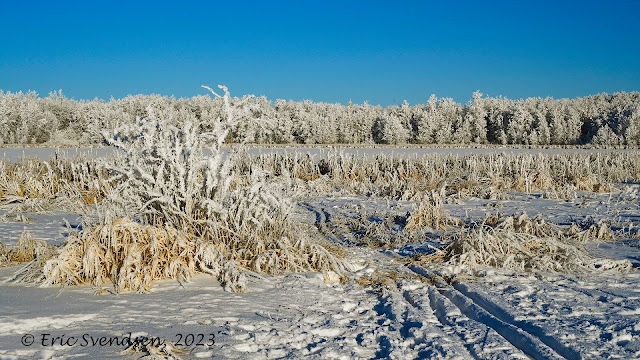Leading the eye - using tracks, trails, and tarmack.
 |
| Ice-covered pond in Innisfail, Alberta, framed by ice-bound vegetation. |
Notice the two parallel lines at the bottom left corner of the image? Those are cross-country ski marks and they serve as a means of leading your eye into the photo. The shot would not be the same without them as the open area would be vacant from anything to capture the viewer's interest. Large, bland areas in a picture tend to render the entire thing mundane. Being too busy is not good, but neither is not busy enough. The trick is in finding the right balance.
One of the great ways to improve a photo with empty areas is to put something there that draws your eye into the shot. In snow scenes, skis, snowshoes, and even footprints will do the job. Sandy areas benefit from footprints and vehicle tracks. Roadways, sidewalks, dirt paths, and train tracks all achieve the same purpose. Even nature provides eye-leading items; rivers, streams, fallen logs, waves, and coastlines all provide mechanisms to draw your eye into the frame.
When out taking pictures I wear my metaphorical photographer's hat. That is to say that I look for elements that will work together when composing an image. Rarely will I photograph a single item (some exceptions exist - namely wildlife photos and this image of an ice-covered tree I took a couple of days ago) as it generally tends to be a weak subject without other supporting components. Instead, I look for a main subject (say a mountain) and ways to enhance its presence through its relationship with surrounding features. Framing, leading the eye, the rule of thirds, and pointing are all mechanisms to improve any given photograph. These represent many of the important ways to take something wonderful and turn it into something amazing.
For leading your eye into a scene, I shoot along the length of whatever it is so that it guides your gaze into the image. I will often shoot from a variety of angles when I come across something visually exciting knowing that I may just find a better angle to shoot from. I vary focal length, position, aperture, camera orientation, and even exposure settings in order to find a shot that I am happy with. Believe me when I say that for every one good shot I make, there are a hundred ones that didn't work out so well. I'm sure greats such as Ansel Adams had an impressive collection of images that were, according to him, underwhelming. Few of us are capable of "One click and done" photography.
I would encourage those who like to take pictures to keep trying. I have been shooting for about 45 years now and I hope to keep improving. Besides, for me, it is more about the moment I capture that image than it is about actually having it.
Thanks for reading.
Eric Svendsen www.ericspix.com



Comments
Post a Comment